Man British
“A man was charged with trespass and possession of a blade last night after an intruder allegedly tried to barge his way into Buckingham Palace. David Belmar, 44, was tackled by police at the Queen’s London home after apparently trying to access the main staff entrance while carrying a knife.”
Are You Ready For Debate Night In New York City?
“R u editorializing, Juan Manuel?”: @deBlasioNYC when I ask abt his ‘skinny’ post-primary schedule. Mentions 2 unlisted Sunday church visits
— Juan Manuel Benítez (@JuanMaBenitez) October 14, 2013
It’s debate night! It’s a bit of down-home tomfoolery, when Bill de Tall-io has to come out and dance on the grave of Mayor Smaug and disregard the terrible gruesome presence of much-hated Republican contender Joe Lhota. All while being peppered with questions from random journalists! Including, we hope, the hot guy from NY1 Noticias.
Hey, you know who hates Joe Lhota? The staff of the MTA. Which he used to run. Funny story.
The Times has a sassy guide to the debate, which includes this advice for de Blasio on the left and Lhota on the right:

5 Quick & Easy Ways to Boost Your Child's Self-Esteem

We all want confident children, but research indicates that effusive parental praise can backfire. In one study, 80% of kids describe their parents’ compliments as “not really true,” “overblown” or “completely full of shit.” Does this mean we’re doomed to raise a generation of children who doubt themselves? Not if we stop praising them unnecessarily. Instead, parents should give their children truly daunting challenges that actually do warrant a flood of praise. For example:
1. Teach your child to do the Heimlich maneuver. Then, pretend that you’re choking on a chicken bone. When your child “saves” you, thank him profusely, through tears. Be sure to tell everyone in the neighborhood about your little “hero.”
2. Show your child how to use a fire extinguisher. Then, leave something flammable on the stove for too long. Your child will feel so proud when she successfully puts out the fire and “saves” everyone in the house! Don’t forget to tell all of the firemen who arrive at the scene about your “brave little firefighter.”
Royal Sanctimummy
Just days after giving birth to the newest heir to the British throne, Kate Middleton, the Duchess of Cambridge, is already eschewing royal custom and taking a hands-on approach to parenting. Friends say that the Duchess, who is “just like any other mum,” has changed several diapers and already visited the popular parenting site Urban Baby seeking confirmation that the infant’s “output” is normal.
3. Teach your child where to find the number for the poison control center. Then take an overdose of medication, but don’t tell your kid what you took. He’ll have so much fun trying to “solve” the mystery of what’s making you turn blue and foam at the mouth! Be sure to leave the empty bottle somewhere — kids just love looking for clues. Your little sleuth will feel so proud when he “saves” you from certain death!
4. Tell your child that you’re dying of a mysterious degenerative disease and that she’ll need to learn how to keep the household running as you slowly lose control of your body and mind. Kids derive so much joy from taking on “big boy” or “big girl” responsibilities! Once your child is scrubbing the toilets, making dinner, and filing as head of household on your yearly tax returns, her self-esteem is sure to skyrocket. Just don’t start taking over “her” jobs or you’ll see an immediate dip in her confidence.
5. Explain to your child that he is the only “real” human being alive, and the rest of us are actually just figments of his imagination, created by the gods to “test” whether or not he’s fit to usher a new generation into the future. Tell him that when other kids or teachers challenge him, it’s crucial to explain to such “heretics” (who aren’t even real in the first place!) that Zambulon, the ancient god of fire, has decreed that thwarting his initiatives amounts to threatening the human race with certain extinction. Once your child sees that he’s the only person on the entire planet who matters, he’ll be so confident that you’ll hardly even recognize him!
Now, be forewarned that any effort to substantially boost your child’s confidence is going to come with some cost, whether it’s a house burned to the ground, a pumped stomach, or a sudden expulsion from school. But once your child’s self-esteem soars sky-high, she won’t remotely mind being hated by all of the adults and children around her. And then you can finally rest easy, knowing that you did your part to ensure that the next generation of children might grow up to become some of the most tenacious, myopic, self-interested individuals ever to have lived. Why, just think of all of the amazing art and poetry and literature that will get incinerated when they start lobbing nuclear bombs at each other!
Heather Havrilesky is also The Awl’s existential advice columnist. She’s also a regular contributor to The New York Times Magazine, and is the author of the memoir Disaster Preparedness (Riverhead 2011). She blogs here about scratchy pants, personality disorders, and aged cheeses. Adorable child photographed by Lance Shields.
Los Angeles to New York City, October 13, 2013

★★★★ Fallen blossoms lay on the tiles of the lit-up apartment courtyard, open to the still-dark sky. The chill was the same as the chill that had come down after sunset, no deeper. Orion stood over the airport valet-parking dropoff lot. Out the windows of the 737, pre-light traced the shapes of mountains. Then red-orange spots lit the left wall of the cabin — higher up than the right-hand windows — their shapes clipped by the passengers’ heads. A coppery glow filled the dimmed cabin, quickly lightening to gold and then on to white. The air on the upslope of the Rockies was “choppy,” the PA announced. It was not so choppy that the attendants would stop serving hot coffee, just enough that they handed over the foam cups with a grim, admonitory slowness. Other people’s weather passed below, hour by hour, till there were the fading green fields of the descent, and color in the trees bordering the highway. The clouds were cottony and stayed cottony even as the plane crossed through them, down into crisp sun on the ground. A white heron or egret scanned the waters below the AirTrain track. The sumac was red now. With the breeze on the train platform, the afternoon was a little cooler than the Los Angeles night had been. Back in Manhattan, with a stronger wind blowing, it was another step colder than that.
How To Survive A Bear Attack
That’s right. As this impressive piece of animation clearly shows, you just grab the bear’s tongue.
Or, of course, you lead it onto a playground. Everyone knows what bears love more than anything.
Yup.
T E T H E R B A L L
The Big Secret Twitter Doesn't Want You To Know That Might Be Killing You
Do you like that Upworthy (Upchuckworthy!) style headline? It might promise quite a lot — but I’m going to deliver.
That’s right. I’m going to tell you the one thing on Twitter that it seems like most people don’t know. And it’s bad for them. And the solution to it? Added bonus: it’s bad for Twitter.
And I’m going to do it for free.
One unintended consequence of Twitter, and it’s a real flaw baked into the medium — (Medium? No pun intended) — is that it’s a fast stream. It probably wasn’t in the first couple years! But now you follow 600, 800, 1200 people. Your Twitter stream is hauling ass.
And then came the notifications, which are multiplying shockingly — “someone favorited a tweet you once looked at sideways while creeping on your ex’s follower list!” So now, unless you’re smart and you turn them off — for the love of cats, TURN THEM OFF — you get a notification by email or by banner or even worse by alert every time someone sneezes in your direction on Twitter.
And yet, it’s still yours. “Each user winnows the data stream in a radically different way,” as the New Yorker put it today. “One subscriber can create a virtual tabloid by following only gossips; another can construct a bespoke community of particle physicists and hot-yoga obsessives.”
What members — creators! — of most of these winnowed communities have in common is one terrible thing. Here it is: they don’t know how to not respond. That’s the secret. It’s the place where everything on Twitter goes wrong. You don’t have to respond to anyone on Twitter. Ever.
Freeing yourself to not respond is a gift. And you can do it for any reason! Here are some reasons you can choose not to respond:
1. You don’t care.
2. You don’t know who you’re talking to.
3. You have actual work to do.
4. Your cats are doing something more interesting.
5. You hate the person who’s tweeting at you.
6. You like the person who’s tweeting at you and you don’t need to fight in public where everyone can see.
7. Because there are better places to procrastinate. Don’t you have a chat room awaiting your input somewhere?
8. You’ve been sitting down for six hours straight and that means you’re going to die early.
9. There are literally one million more reasons.
Recently, the famously argumentative Glenn Greenwald learned an important lesson: he doesn’t have to respond to every egg icon and #tcot spammer that tweets at him — and that’s a lot of eggs and conservative wingnuts. He’s free now! Free from a life of strife. If you survey his whole feed these days, you’ll find him having a few side conversations, and actually being quite funny, which is relatively new for him, but no feuding, no arguing. Well, mostly.
@TomCooper @Asher_Wolf @ioerror I suspect you’re a moron who mistakes your own fantasies for realities.
— Glenn Greenwald (@ggreenwald) October 3, 2013
Haha, that’s a good one. Anyway. This is quite a feat, with 275K followers.
There is a total shitshow unfolding in the greater Ruby community, which apparently, when you are a Ruby developer, you constantly attend conferences. This seems counterproductive and also not very fun, but what do I know? This is the story of what happened to one woman at such a conference. It’s not good. It’s really bad. Obviously, a lot of people got involved in talking about it. Some less well. Many of them did not need to say anything.
Being called a ‘slut’ ‘whore’ etc won’t get me to take it down. Not this time. For every troll I have 50 more supporters. That’s progress.
— Justine Arreche (@SaltineJustine) October 12, 2013
But there is a conversation that needs to happen, right? Here is but one of many tough but important conversations that ensued, in which David Heinemeier Hansson, the creator of Ruby on Rails, felt compelled to involve himself by saying he wasn’t going to involve himself.
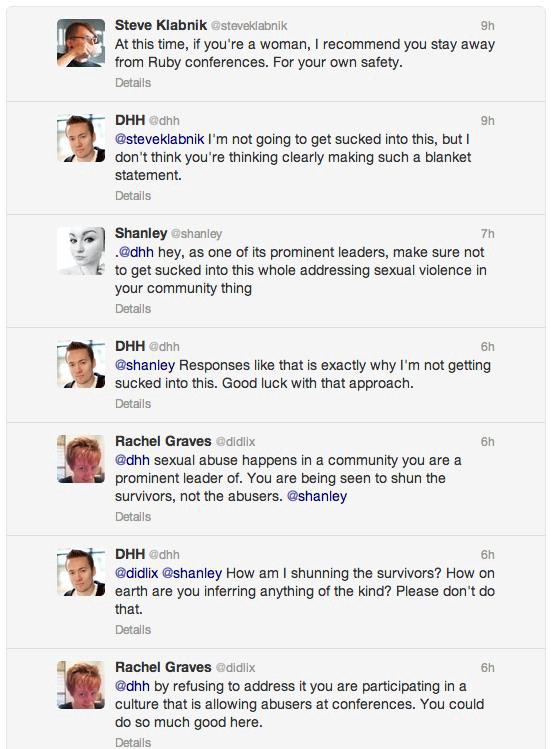
Where did that go wrong? Looks obvious.
At least some of these branching conversations went places.
@ginatrapani @steveklabnik I’m even more keenly aware of their limitations.
— DHH (@dhh) October 14, 2013
Look! Everyone said what she or he had to say. An agreement was not made. Unfortunate. Oh well. Everyone got on with life. No one made a courtesy “end of conversation” favorite either.
Others took it to their blogs, with well-meaning and mathematically interesting posts, which include unfortunately an impossibility: “women making sexist comments to men.” (There is no such thing, just FYI.)
Some of these branching conversations online went to bad places. And some became a veritable advanced placement class in what not to do.
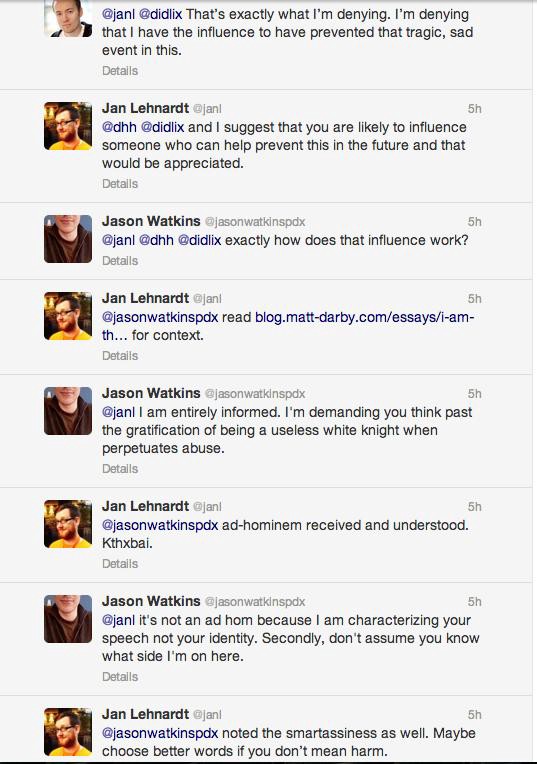
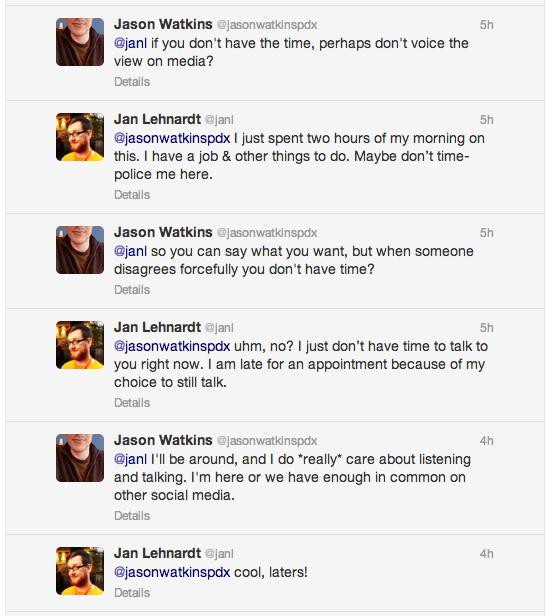
Not to “time-police” anyone here but, why? Why would you do this to yourself, to other people?
What’s interesting is that it’s the white dudes who are all flapping their hands, all upset that now there’s “two sides” in the community. (There always were two sides, fellas.) All these poor white dudes are really scared of conflict, it looks like. Yet they are always willing to respond, making their positions ever-weaker. You’d think they’d recognize their position of power and use it in the traditional manner: silently.
@swombat @tundal45 Good classification. I think there’s little to be gained from speaking up in the middle right now.
— Andrew Cox (@coxandrew) October 14, 2013
That’s right, for the wrong reasons. The best thing we can steal is the privilege to be silent. Old white men have been using silence for centuries, obviously. That’s because it works. You’ll enjoy it too. And you’ll get to spend more time with your animal companion of choice.
The Daily Dot made those gifs of the enigmatic and wealthy Jack Dorsey!
Won't You Save These Homeless Long Words? Send Help Now, Some Stories Are Going Unread!

Longreads wants you to become a member. What do you get? The thing I like best is exclusives: advances on stories before publication. Also I like it when some weirdo I don’t know recommends a bunch of stories that maybe I haven’t seen before. I do like that! Anyway I gave them thirty whole dollars for a year’s membership. That’s right, for just $2.50 a year you can keep some starving words from being homeless, won’t you give today.
How Did Pumpkin Become Beloved? Labor, Nostalgia, Refreshment And White Women
by Johannah King-Slutzky
This story begins, like so many before it, with a marathon session of “Sabrina, the Teenage Witch.” Specifically, the show’s 1999 Halloween episode, “Episode LXXXI: The Phantom Menace.” (STTW has a real gift for prophecy.) Sabrina, played by Melissa Joan Hart, is a faux black sheep with a heart of gold; her manager (cum boyfriend cum soon-to-be-war-photographer) is as auspicious as he is handsome — which is a lot — but is also a bit dunderheaded. The setting: a Central Perk knockoff:
JOSH: Y’know, I’m really surprised our special pumpkin flavored coffee hasn’t been more popular.
SABRINA: Do you think it has anything to do with the fact that it’s a hideous shade of orange and tastes like pumpkin?
It’s 1999, four full years before Starbucks will introduce the Pumpkin Spice Latte. The scene is played for easy laughs. But two years later (in “Making The Grade,” aired 2 Feb, 2001)…
JOSH: A pumpkin bagel comin’ up. [Walks to counter.] Hey, where are the pumpkin bagels?
HILDA: In the pumpkin bagel patch?
JOSH: Huh?
HILDA: In the interest of lowering overhead we are no longer in the exotic carbohydrate business. […]
JOSH: Hilda, we have an eclectic, sophisticated clientele, all right?
It’s still two years before the advent of the Pumpkin Spice Latte. But pumpkin’s transformation from rube holiday fare to the “exotic carb” of sophisticates was centuries in the making. Probably without realizing it, the sitcom savants at “Sabrina” had tapped into a set of particularly American themes (the celebration and denigration of farm life, anxiety over work ethic, a sturdy fetish for the authentic) that have been playing through the scrim of pumpkin iconography since Pilgrim hit rock in 1620.
Long haul historical materialism suits our favorite gourd (squash, if you’re feeling sober), but pumpkin’s story isn’t over, either: when I checked Google Ngrams it showed a substantial uptick in pumpkin buzz beginning around 1960:
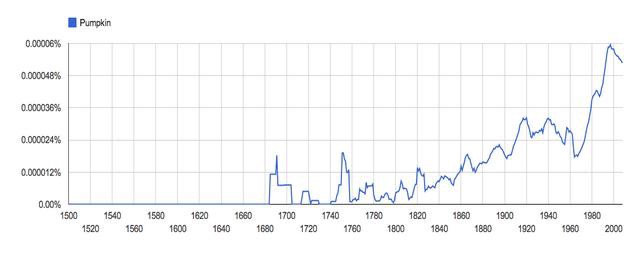
This graph isn’t entirely fair, as pumpkin used to go by “pompion” — that is, when it was differentiated from squash at all — but you get the gist.
What’s giving pumpkin its added boost? For starters, it probably has something to do with the Pumpkin Spice Latte (PSL), which celebrated its 10th birthday this fall. I emailed Starbucks to ask about the drink’s branding; they declined to comment. Instead, let’s check out Instagram.
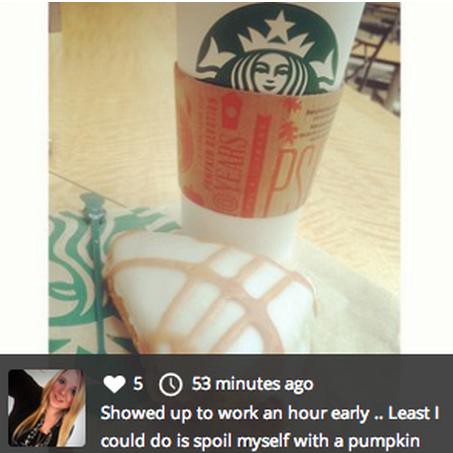
Desktop title: “I spoiled myself.”
These were all taken on September 3, the day the Pumpkin Spice Latte officially debuted for its 10 year anniversary. The themes are remarkably consistent with fruit’s historical lineage, with the drink — which does not contain any actual pumpkin — marking seasons, labor, decadence, and moral submission.
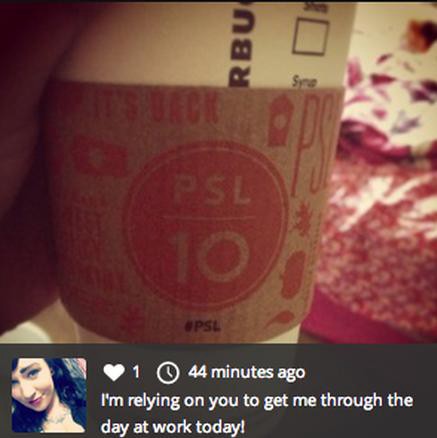
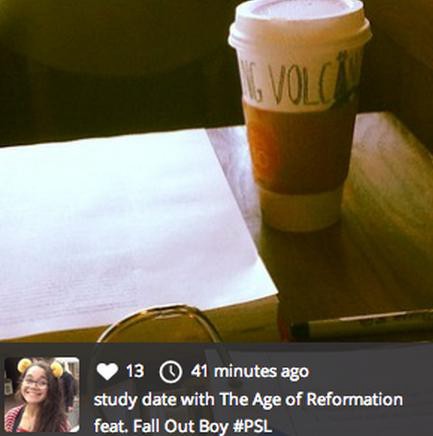
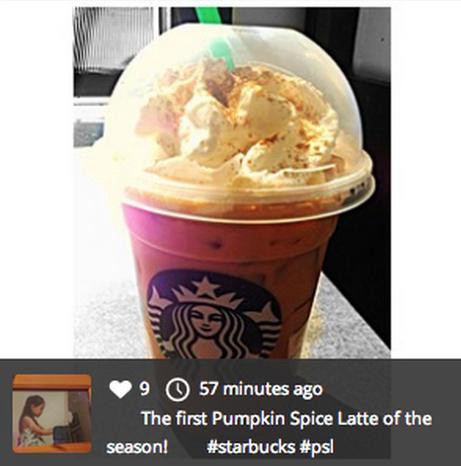
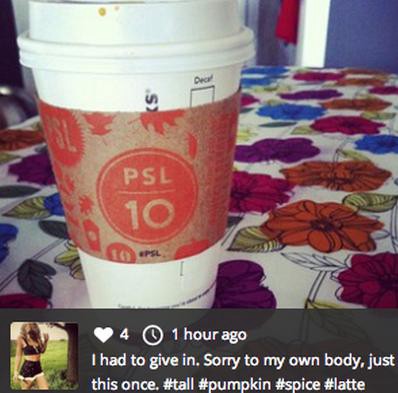
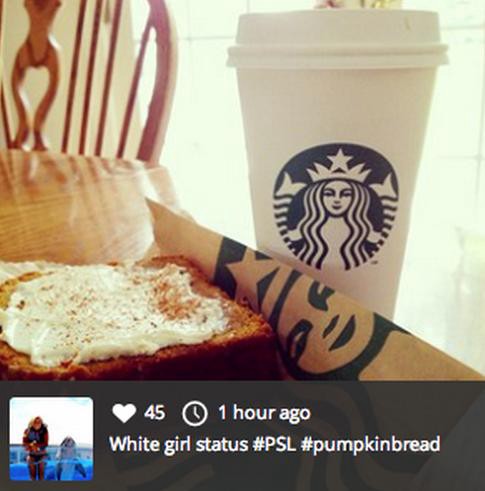
Delighted by casual racism and my own maverick sense of punch, I decided to search twitter for “#whitegirltweet” on a whim.
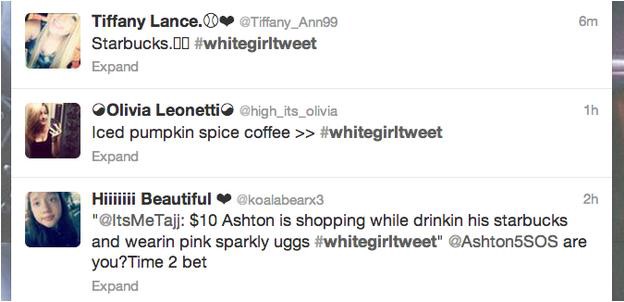
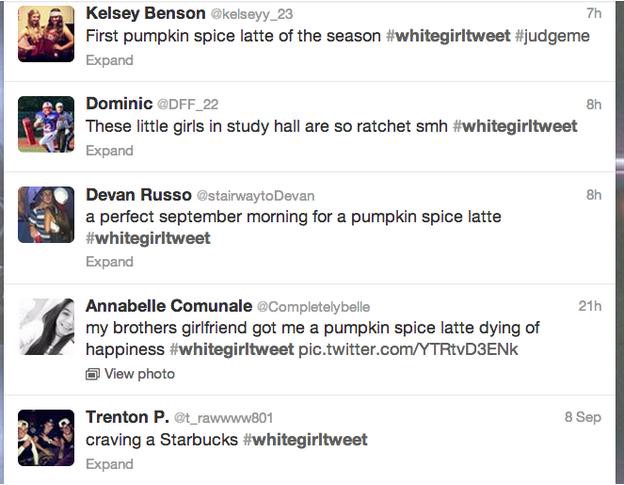
Verdict: 87% of whitegirl tweets are about Starbucks.
What’s particularly interesting about these photos is the way “treating yourself” keeps popping up. Pumpkins have always been associated in turns with simplicity and decadence, but usually pumpkin-obsessed Americans choose one or the other per generation and stick with it. This anxious “work hard play hard” thing is new. Bikini bod consumes PSL “Just this once,” the apology averring her babely norm. Office maven joins office early. “Least I could do,” she opines, “is spoil myself with a pumpkin.” Other times the causality is reversed, with pumpkin as incentive, not reward. I particularly enjoyed that the topic of one PSL study session was The Reformation, whose resistance to ceremony and pomp perfectly mirrors the pumpkin’s own attempts to cleanse. When I spoke with Dr. Cindy Ott, author of Pumpkin: The Curious History of An American Icon and to whose compendium I owe a big debt, she suggested that part of the appeal of the pumpkin as a dessert food is that it “it feels like you’re doing something good for yourself” — the perfect cultural balm for anyone chowing down on a pie, bread, or “with whip” latte. Add that to the cool factor of witchy 90s nostalgia and you’re in SEO heaven.
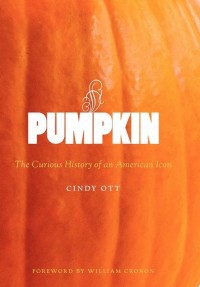
Cindy Ott’s Pumpkin: The Curious History of an American Icon is available wherever you prefer to purchase books. Dr. Ott teaches in the American Studies department of Saint Louis University and is also the author of “Crossing Cultural Fences: The Intersecting Material World of American Indians and Euro-Americans” and “Why Lewis and Clark Matter: History, Landscape and Regional Identity.”
The strange truth of the matter is that pumpkin’s associations are entirely imagined. Pumpkin is genetically identical to squash, and while squash — native only to the Americas — is privileged in most Native American religions, the orange globes we identify as pumpkin were treated with no special regard and were not served at the first American Thanksgiving nor carved for the first jack-o’-lantern.
Decadence, however, is an old association for squash, whose round shape and easy cultivation made the gourd a common target for creation and fertility tales. In Seneca and Huron mythology, for example, squashes sprout from a Great Spirit’s abdomen and head wherever she walks. The fecund associations of pumpkin were preserved by colonists who brought pumpkins back to Europe as souvenirs. Growth is even in the name — Europeans’ “Pumpkin” (earlier, “pompion”) comes from the Latin “Pepo,” which means to ripen or “cook by the sun” (OED).The first transatlantic squash seeds were disseminated through Europe as thank you gifts to royal patrons within 25 years of Columbus’s 1492 voyage, and pumpkin further permeated the market in the 16th century thanks to classicism, one of whose features was the fascination with Wunderkammer-like Herbals.
If you’re looking to simplify pumpkin’s history into a narrative of labor (I am), fertility poses somewhat of a problem, toeing as it does the line between decadence and simplicity. Pumpkin is decadently fertile, but in the Netherlands pumpkins became an icon of base nature and unsophistication — much like Josh’s boneheaded idea to inject his coffee with pumpkin in “Sabrina, the Teenage Witch.” In Joachim Beuckalaer’s The Country Market, for example, a woman gropes/is groped by pumpkin and man (respectively) in the hip hop-like pose of a woman prepared to get laid.
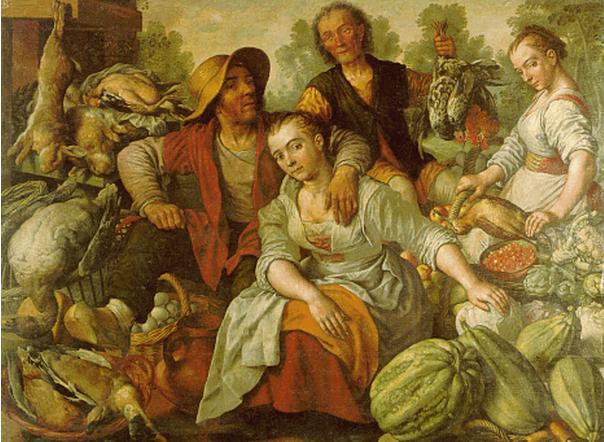
Joachim Beuckelaer (Dutch, 1533–1574), “The Country Market,” undated.
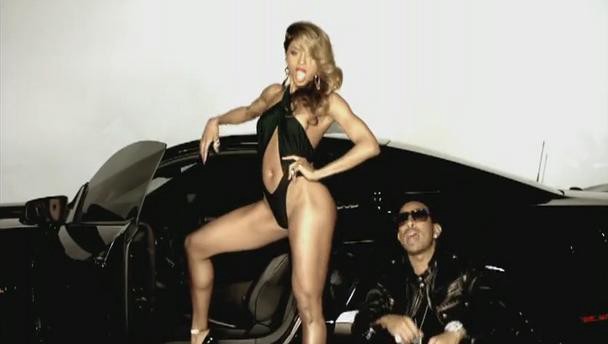
Just for fun. Still from Ciara’s “Ride,” ft. Ludacris (2010). Some things really are universal.
On the less sexy end of the rube spectrum, pumpkins have been associated with stupidity since the Roman philosopher Seneca auspicated the tradition of “pumpkinheads” in his rebuke of Emperor Claudius. And Falstaff, dum-dum par excellence, is characterized by Shakespeare as a “gross watery pumpion [pumpkin]” in The Merry Wives of Windsor. Like Claudius (and sort of Falstaff), the anthropomorphic pumpkin is always foolish yet aggressive: Before there were scarecrows and jack-o’-lanterns, Americans traded folk tales about animated vines and pumpkins so huge they had to be harvested by teams of axe-wielders, only to find their faith belied by a family of pigs trapped inside.
Although European treatment of pumpkins tended toward insult, Americans adopted the gourd as a positive symbol of New World perseverance. For example, a colonial song from from 1630 (reported in San Francisco’s 1891 Daily Evening Bulletin) reads:
Instead of pottage and puddings and custards and pies
Our pumpkins and parsnips are common supplies
We have pumpkins at morning and pumpkins at noon
If it was not for pumpkin, we should be undone
That being said, pumpkin was decidedly low class. New Englanders were called “Brother Jonathan and pumpkin pie” to signify their bumpkinhood and Puritans demeaned the pumpkin as callow and ill-restrained when they chastised — yes, chastised — Thanksgiving feasts as “St. Pompion’s Day.” Up until the 19th century, pumpkin was eaten primarily as slave and hog feed or as a poor man’s alternative to sugar cane, molasses, or malt.
A hole in that ideology is pumpkin pie. The first American cookbook, American Cookery (1796), featured a pie recipe loaded with rich cream and eggs. The recipe’s inclusion in a cookbook at all is notable, since lower class women worked mostly through oral tradition. But Cookery’s subtitle reads, “Adapted to this country, and all grades of life.”
Unlike Europeans, Americans had to contend with rural strandedness in a way that was trenchant yet inoffensive: thus, 58 years behind the first published pumpkin pie, we find the Hudson River School. In Walden, Henry David Thoreau addresses the pumpkin with a mix of reverence and condescension:
I would rather sit on a pumpkin and have it all to myself than be crowded on a velvet cushion. I would rather ride on earth in an ox cart, with a free circulation, than go to heaven in the fancy car of an excursion train and breathe a malaria all the way.
The pumpkin is an aesthetic object whose value is spiritually good but never rarefied. One suspects Thoreau’s review would be less glowing should the pumpkin seat a different occupant. The appeal is in coaptation of brain to nature; an actual hillbilly wouldn’t be celebrated.
Thoreau’s reference to a “fancy…train car” is no accident, either. Even in the 1800s, pumpkins — and the rural work ethic in general — were full of nostalgia for the pastoral imagined past. Thoreau’s is a longing for a place, time, and set of behaviors which will clean us out and make us good again. It is no accident that Thanksgiving became a national holiday in 1863, during civil war. Our collective nostalgia is not simply biographical — although it is true that farmers felt emasculated by industrialization — it is an epistemological nostalgia for innocence. To quote everyone’s favorite folly, Secretary of State William Seward, Thanksgiving (and its metonym the pumpkin) is “humble penitence for our national perverseness and disobedience.”
One side effect of Thanksgiving’s Civil War lineage is that family is front and center in all Thanksgiving-themed conversations — a function, in part, of Seward’s suggestion that Americans pay mind to the ubiquity of “harmony” “everywhere except in the theatre of military conflict” and the tendency of abolitionists and civil war pundits to talk politics through the metaphor of domestic living. Pumpkin also has strong family connotations, thanks to the communities in which it was grown during America’s inception — generally, family farms or plantations.
But by the mid-late 1800s agriculture trends were all about big crops like corn and cotton, and in 1870 The Horticulturalist remarked, “It is about time that pumpkins were retired from service and entered upon the fossil list.” Ironically, it’s the very anachronism of pumpkin as agriculture that contributed to its romantic image. As the invent of state parks attest, 19th century Americans preferred to keep their nature intimate yet physically removed. The same year The Horticulturalist called pumpkin a fossil, the American Agriculturalist featured a pumpkin on their masthead. Farmers at this time grew mammoth pumpkins for prizes at state fairs, not as subsistence or commodity crops. The further pumpkin got from the real American economy the more it became ballast for our identity as hard workers.
Just as pumpkin connotes family, in the late 19th century some of those family values spilled over into moralizing Victorian tales who use animated pumpkins to distinguish between good and bad behavior. My favorite is a story read to me during my own childhood — William D. Howells’s The Pumpkin-Glory, in which “there were two little pumpkin seeds, and one was a good little pumpkin seed, and the other was bad — very proud, and vain, and ambitious.” There are some great holes built into the story’s own ideology, but the tl;dr is that a pumpkin seed dreams of becoming a morning glory, is derided by family, falls in a barn, and is eaten by a sow. The “good pumpkin seed” brother knows his place, becomes a predictable pumpkin, is made into pie. Good ol’ 1892. Also, this happens: “It was like getting scalped, but the pumpkin didn’t mind it, because it was just the same as war.”
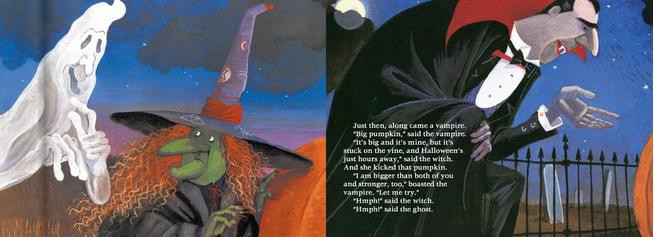
Pages from “Big Pumpkin,” by Erica Silverman (1992). Technically not Victorian but the formula is the same: Family + Labor = Childhood = Pumpkin.
It’s incredible how formulaic cultural associations are when it comes to pumpkin. One of the most glaring facts of my social media survey of the pumpkin spice latte was how many PSL Instagrammers were female and white. I suspect this has less to do with actual consumer demographics and more to do with branding — the Pumpkin Spice Latte has an image that is in some way consistent with whiteness and femininity. (Not to muddy the waters, but for one thing, unlike pumpkin, the PSL is a dessert, which has its own gendered expectations.) My guess is that the PSL #whitegirltweet is about compliance and agency: white girls are expected to be unabraisive and docile — young women who still obey their fathers. Abstracting #whitegirl to those levels is useful because similar associations pop up in the late 1800s with the Victorians’ and Romantics’ mutual fixation on childhood.
Pumpkins are a particularly good icon of ungreedy labor because besides not being worth much they cannot be farmed with machines. Mammoth pumpkin raising guides repeatedly reference the fickleness of the gourd, whose genetics only vaguely predict color and thus saleability. When harvesting pumpkins, most of the work must be done manually. Technology was entirely out of the equation until 1955, when for the first time farmers stopped cutting the seasonal fruit from the vine by hand. Almost no machine can be used on ornamental pumpkins because the skin must remain pristine, and unlike other vegetable crops, pumpkins really are grown mostly on small family farms, though often these family ventures sell the experience of pumpkin picking, not actual pumpkins.
This labor-intensive, modest family ideology is so compelling that canned pumpkin behemoth Libby’s (Nestle) even sells this vision to their very farmers. According to Cindy Ott, “Rather than illustrating [Nestle’s] 2000 annual report with the most advanced and up-to-date equipment used to harvest and process pumpkins, the cover featured Newhauser, who was wielding a small pocketknife in the middle of a pumpkin field.”
If pumpkin is so modest, how did it become the carb of sophisticates? For one thing, the midcentury fixation on canning made unadulterated unprocessed pumpkin the sort of add-in only Martha Stewart (or these days, Smitten Kitchen) types could will themselves to pull off. Similarly, in a perfect synchrony between art and economics, mid-century kitsch by way of Norman Rockwell and (sorry, but) Charlie Brown made the ideal pumpkin perfectly round and glowingly orange, with beefy annulations — to which Post-Fordist family farm style zeitgeist has responded by encouraging the purchase of “heirloom pumpkins,” which you can now buy from Whole Foods.
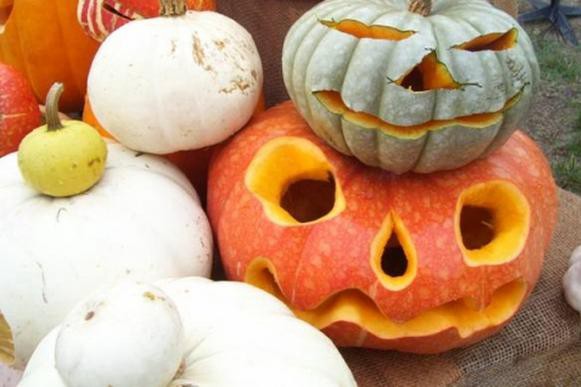
Heirloom Pumpkins at Whole Foods.
And because pumpkin is obviously a dessert, amp up your kitchen cred by using pumpkin as a bowl from which to serve your rustic black bean pumpkin soup, which Smitten Kitchen describes as perfect accompaniment to “a crusty piece of bread, …substantial enough to be a meal.” Thanks to the overpowering normalcy of midcentury pumpkin iconography, post Fordist pumpkins can afford to be both sophisticated and modest.
When I spoke with Dr. Ott over the phone I asked her if she thought our attitude toward the rural work ethic had changed since Thoreau’s time. “This isn’t ideological,” she said, “but one basic difference is that a lot of those people were raised on farms and then moved to cities….People stress about going back to this good basic way of life even though they’re not sure what exactly that entails….It resonates deeply that we got rid of all the farms. It was erasing a deep part of who we are. It becomes this cultural, national heritage as opposed to this specific change within families leaving the farm and going into the city.” Though that doesn’t explain whether we are any more or less condescending now than in 1854, it at least explains why farm realism takes the form of warty gourds and not pumpkins with nicks in their skin — “authentic” pumpkins contain only imagined blemishes.
The other big change, of course, is that pumpkins are now also mischievous — a weird afterthought for a squash dedicated otherwise to advertising our wholesomeness. The first jack-o’-lanterns (an Irish tradition, if the name didn’t give it away) were actually carved out of turnips. Jack-o’-lanterns weren’t recognizable to the American public in any form until the late 19th century, although its antecedents (Will-o-the-wisp, the “The Legend of Sleepy Hollow”’s Headless Horseman, Nathaniel Hawthorne’s “Feathertop”) predate full-on jack-o’-lanterns by about 50 years. It wasn’t until 1897 that the Ladies Home Journal suggested, “To add weirdness and quaintness, have plenty of jack-o’-lanterns made of pumpkins” — clearly still novel, though to be fair, “quaint” and “weird” remain on-trend today. Spookiness probably isn’t about labor — but it is about nostalgia and the last gasps of childhood, only a stone’s throw away from the anxiety that permeates more wholesome pumpkin Americana.
In the last two decades, Halloween mystique has ballooned, thanks dually to the ever-enthralling gleam of Christmas Creep and the nineties’s witch fetish. The Pumpkin Spice Latte is itself actually a product of Christmas Creep. When I emailed Melody Overton, who runs the popular Starbucks blog, Starbucks Melody, she wisely pointed out that “[I]n 1986, the Eggnog Latte was an October beverage. But now the Eggnog Latte is a November beverage as fall has developed and taken on its own unique celebratory feel.”
#PSL = proof that fall loves you.
— Starbucks Coffee (@Starbucks) October 4, 2013
Certainly pumpkin’s star was rising before 2003, the year of PSL’s debut. But in the last decade, pumpkin’s connection to Starbucks has become indelible (even with McDonald’s introducing their very own, and much less expensive, Pumpkin Spice Latte). The drink is, to quote Starbucks Melody, “dessert in a cup…part of that cultural fall [sic] wallpaper.” Her otherwise flattering diction intrigued me. Cultural wallpaper? It has been remarked (by Roland Barthes, no less) that modern advertising portrays certain foods as both stimulant and opiate:
For centuries, coffee was considered a stimulant to the nervous system…but contemporary advertising, while not expressly denying this traditional function, paradoxically associates it more and more with images of “breaks,” rest, and even relaxation. What is the reason for this shift? It is that coffee is felt to be not so much a substance as a circumstance. (PDF)
Likewise, “feelings of guilt [were] fostered by an advertising for sugar which emphasized pure enjoyment.” Pumpkin’s synchrony with sweet coffee is incredible: like regular coffee, the PSL is decadence tempered by labor, stimulating yet relaxing. It is a way of spoiling yourself that you earn. And, like sugar’s sweet spot, the PSL is not pure bliss: remember, you worked hard to deserve it. In this way, Melody’s description of the Pumpkin Spice Latte is telling: it is “cultural fall wallpaper” — that is, like a snack (but on a seasonal rather than daily scale), both routine and celebratory.
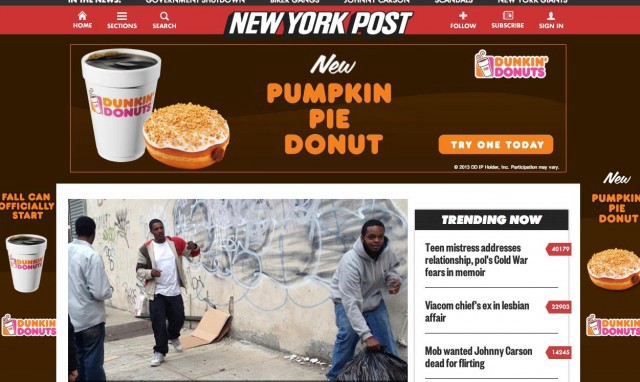
“Fall can officially start” is the marketing slogan for Dunkin’ Donuts’ “pumpkin pie donut.”
Pumpkin’s current position as icon of cool is particularly confusing because coolness is neither wanton nor modest — it requires of its wielders emotional restraint and consumerist peacocking. But perhaps it is this very tension in the ideology of cool that makes pumpkin so appealing to contemporary palettes — split evenly between decadence and modesty and wracked by a peculiarly American guilt, the pumpkin is the coolest melon around.
Johannah King-Slutzky is confused. She writes poems and blogs about TV here. Follow her on twitter @jjjjjjjjohannah.
